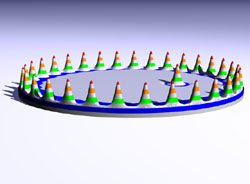New Instrument for Solo Performance

Surprisingly organized structures sometimes appear in apparently simple systems, such as the patterns that can form in a shaking tray of sand or in a heated liquid. Now a team reports in the 13 May PRL that a magnetic field can sustain an isolated hump on the surface of a soup of magnetic nanoparticles. Among pattern forming systems, it’s the first example of a solo feature that doesn’t require the continuous input of energy that normally prevents such features from falling apart. Researchers expect it to provide a new test case for theories of pattern formation.
Patterns form everywhere in nature–spots on leopards, spirals on pine cones, and wrinkles on skin. Researchers believe there are general principles underlying most pattern forming systems, and they want to fully understand controlled examples in the lab, such as the regularly spaced hills that can form in a shaking tray of sand, the spiral or circular waves that appear in growing bacterial colonies, or the regular “fingers” that protrude from a growing crystal.
In a few cases, solitary features called solitons can also form–isolated humps in shaking sand, for example. Some researchers consider these the “irreducible units” of repeating patterns and want to understand their behavior as one important piece of the pattern formation puzzle. While repeating patterns form easily, a soliton would quickly fall apart if it were not stabilized by special conditions. Ordinarily there’s a delicate balance between a continuous input of energy that tends to enlarge the feature, such as shaking the sand tray, and the loss of energy known as dissipation that tends to shrink it, such as the friction among sand grains.
Reinhard Richter of Bayreuth University in Germany and Igor Barashenkov of the University of Cape Town in South Africa discovered a stable type of soliton that requires no energy input or dissipation; instead, it’s stabilized by a balance between magnetism and gravity. The team poured a thick mixture of kerosene and 10-nanometer-wide particles of rusty iron onto a dish and applied a magnetic field. For certain strengths of the field, patterns of Hershey’s-Kiss-shaped humps form on the surface, as others have shown in the past. The humps are the surface configuration that balances gravity and the magnetic force: The field magnetizes the fluid and tries to lift up as much as possible without carrying too much weight.
But for a particular strength of the field, Richter and Barashenkov found that by placing a smaller hand-held electromagnet under the dish, they could create isolated humps on the flat surface. The humps stayed in place after they switched off the extra magnet, leaving the main field on. At this relatively weak field strength, humps are stable but require an extra “push” to be created.
Richter says such solitary structures were thought possible theoretically, but this is the first time they have been observed. “It turns out that dissipation is not required for having stable, isolated structures.” Hermann Riecke of Northwestern University in Illinois agrees. “It is a very clean experiment,” he says. The simplicity of the setting, Riecke adds, could make it possible to carry out more experiments, for instance to understand the subtly different properties of the isolated humps.
–Davide Castelvecchi
Davide Castelvecchi is a freelance science writer in Rome.


